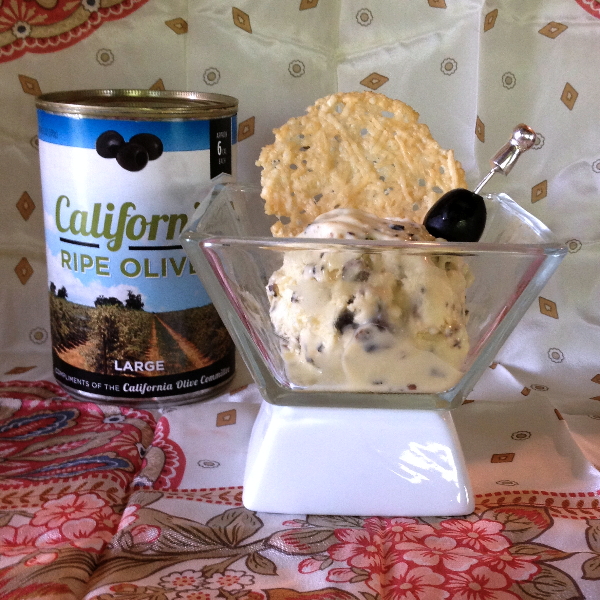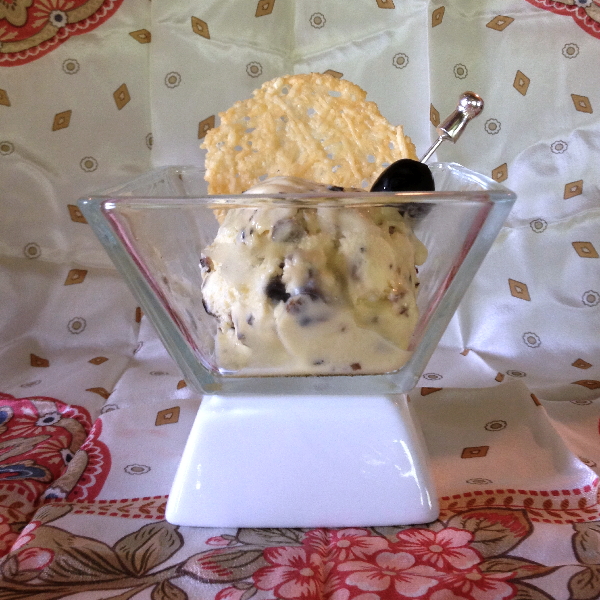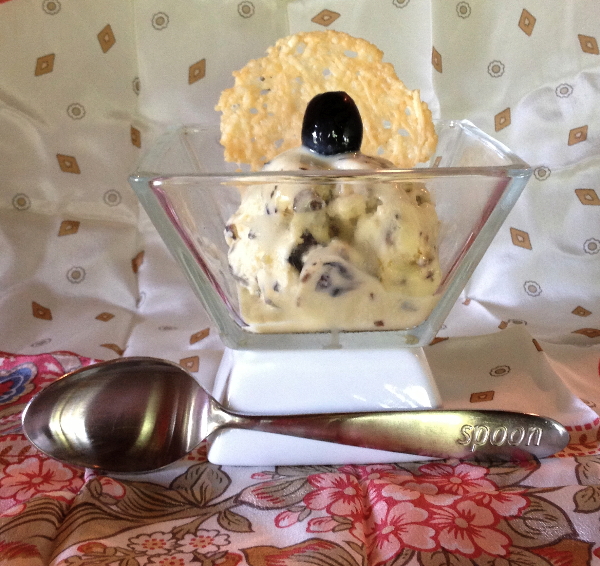The following is a guest post by my husband, Mike, a/k/a “Mr. Flamingo”. Mike is also a registered participant in the upcoming Eat Write Retreat food blogger conference, and as such, received his own mystery ingredient box and some special tools from OXO to participate in the EWR Culinary Challenge. His challenge ingredient: California Ripe Olives. As a student of history and a darned good cook in his own right (Did I ever tell you about our first date? No? Another time.), Mike especially enjoys the history behind the products we use and foods that we eat, and he was really taken with the history of California Olives. But, I’ll let him tell you about it.
The Hessians are coming! The Hessians are coming! … With olives.
Behind every Greek hero, Roman senator, and Spanish conquistador stood a good…olive. The path of Western civilization might as well pass through the roots and branches of the olive tree, since every one of these ancestral empires relied on the olive to survive. So, America owes its favorite martini garnish to some unsung Mediterranean olive mogul who spread olive trees across America like some latter-day Giovanni Olive-seed, right? Nope. Not even close.
America’s olive capital is California, and it owes its $53 million a year olive industry — and America owes its love affair with the little green fruit – to a 19th century German immigrant who probably never gave the olive a second thought until she was fifty-six, widowed, and practically penniless.
Freda Ehmann managed to escape Germany’s Hesse-Kassel (yes, the very same Hesse where Britain recruited mercenaries to fight in the American Revolution) when it suffered its own revolution in 1848. Freda married another refugee, Dr. Cornelius Ehmann, and the story might have ended there with Freda and Cornelius living a long, prosperous and relatively anonymous life in Illinois, had Dr. Ehmann not died in 1892. Freda sold off everything and moved to join her son in California, who convinced her to invest virtually all of her money in an 1800 acre olive grove. Then the bottom fell out of the real estate market; Freda was left with twenty of her original 1800 acres, and the advice of the men in her life— including her son— to simply give up and declare bankruptcy. Freda, however, hadn’t survived the vicissitudes of revolution and exile in order to surrender to fate. She was about as eager to declare bankruptcy as she was to stand stark naked for an afternoon on San Francisco’s Embarcadero. She decided to make a go of her twenty acres.
The problem was, Americans liked olives alright, but olives didn’t like to travel much. In the era before refrigeration, the best way to send produce long distances was to can it, but the canning methods of the day weren’t up to preserving olives— or at least, any olives anyone would want to eat, because not only did they taste terrible, they ended up looking like the losing boxer in a punishing match. They came out of the can in splotchy shades of orange, purple, black, brown and any other number of equally nauseating color combinations to match their unsavory taste.
Freda thought she could do better. She set up her laboratory— a couple of wine casks cut in half— on her daughter’s back porch in Oakland and spent every day from dawn to considerably after dusk perfecting her recipe. Thanks to Freda’s straitened circumstances, everything was done as economically as possible, and that included the backbreaking labor of carrying gallons of water to the casks by hand. The resulting olives weren’t any more decorative, but the taste was vastly improved. When Freda brought some to the dean of the local agricultural college, he told her they were the best olives he’d ever had. And so did hoteliers and merchants, first in Seattle and Vancouver, then Philadelphia and Chicago, and then across the country, and she soon had more business than she could handle. By the time Freda passed on in 1931, she was the undisputed empress of California olives, buying the crops of hundreds of other olive growers in California’s Central Valley and canning them in her own massive Oroville plant. Today, there are two canners of olives in California, and both are multi-generational family businesses: Bell-Carter Foods, Inc. / Lindsay Olives in Lafayette, and Musco Family Olive Co. in Tracy.
So here’s my tribute to the uniquely independent Freda Ehmann— a California ripe olive gelato appetizer that I hope is as memorable and individual as she was.
You might think that gelato is an unusual choice for an appetizer. That olives are a choice garnish for the cocktail hour is no surprise, and they’ve been the inspiration for countless tapenades, salsas and salads, but the sweet richness of olive oil gelato provides a worthy backdrop to the fruity taste of the black olives and the flaky texture of Maldon salt for a special appetizer that will surprise you. Maldon salt is hardly news on the culinary scene, but for those of you who may not have encountered it, it’s literally salt harvested in Maldon on England’s North Sea coast. The process yields a mild, flaky salt with great texture and no bitterness. If you don’t have access to Maldon salt, you can substitute kosher salt, or even a medium coarse fleur de sel (if you want a bit of crunch in the finished product). Do not try to substitute table salt, as that would affect both taste and texture— and not for the better.
Since this is an appetizer, I consider it prime dinner party fare, so the amount below easily serves 8-10. It’s rich, but not as rich as a dessert gelato, and I’ve already reduced the sugar from standard gelato recipes, so the sweetness takes a bit of a back seat to the saltiness and subtle brininess (is that a word?) of the olives. Although the Parmesan Tuiles are an optional garnish, do make them. The tuiles add another layer of savoriness and really enhance the olive flavor.
California Ripe Olive Gelato (serves 8-10)
- 1 1/4 cups sugar
- 3/4 cup water
- 1 1/2 cups whole milk
- Large pinch kosher salt
- 8 egg yolks
- 3/4 cup olive oil
- 6 oz. (1 can, drained) California ripe olives
- 2 1/2 teaspoons Maldon salt
Stir together the first four ingredients in a saucepan and place on moderate heat. Stir occasionally. When you see little bubbles forming against the sides of the saucepan, it’s ready.
In a separate bowl, beat the egg yolks until they’re frothy.
Now comes the “tricky” part. Pour the contents of the saucepan in a thin, steady stream into the beaten egg yolks, while continuing to beat the yolks. Pour the resulting mixture back into the saucepan and stir over low to medium heat until it’s a thin custard, i.e. you can dip a wooden spoon into the mixture, draw your finger across the back of the spoon and leave a clear path that doesn’t fill in. Needless to say, perform this part carefully or you’ll be eating an omelet and not gelato!
Make an ice-water bath, filling a large bowl or pan with ice and water, but leave enough space for the bowl you’ll be mixing the custard in.
Pour the custard into the empty bowl that you set in the ice water bath, and whisk it until it’s cool. If you think a little scrambled egg formed in the custard (despite your best efforts) while it was still in the saucepan, you might want to pour the custard through a fine mesh strainer into the bowl in the ice water bath. Pour the cooled custard into a container, cover, and put it in the refrigerator overnight (or minimum 6-8 hours).
Drain the olives, setting aside a few whole ones for garnish.
Remove the custard from the fridge, and whisk in the olive oil while pouring into the custard in a thin, steady stream. Once it’s thoroughly mixed, put the custard in your ice cream maker and let it churn until it’s the consistency of soft-serve ice cream. Meanwhile, roughly chop the drained olives in your food processor (pulsing it about six times should give you the right consistency). You can also do this by hand.
When the gelato in the ice cream machine is ready, pour it into a large bowl. Fold in the chopped olives and salt until the pieces are well distributed. Work quickly, because the gelato will be doing its best to melt into soup, and instead of being spread throughout the gelato, the olives will end up falling into a layer on the bottom.
Spoon/pour the gelato into a container, seal, and keep in the freezer until you’re ready to serve it. (Note that the taste of the olive oil will get stronger with time.)
*Optional Garnish: Parmesan Tuiles (or Fricos)
- 1 to 1 1/2 cups grated Parmesan cheese
Preheat the oven to 400º F. Prepare a baking pan by lining it with either parchment paper or a silicone pan liner.
For each tuile, place 2 Tablespoons of cheese in a mound on the baking pan, about 2 inches apart (they will spread). Bake for about 3-5 minutes, or until the cheese has melted and flattened out. Allow to cool on the baking sheet until the cheese has set. Remove to a sheet of paper towel to blot any excess oils. Serve within several hours.
I hope you’ve enjoyed Mike’s contribution to the blog today, and that you’ll try this recipe. We’ve been addicted to it since he received his Eat Write Retreat mystery box and was inspired to create this ingenious and unexpected appetizer!




I never would have considered olive gelato but that looks really good. 🙂 Kudos, Mike!
Oh wow, this is incredible! It’s a fantastic idea for an appetizer at a dinner party. I especially loved reading Freda’s story-I had no idea that olives had such a rocky start in this country.
Love this post!
Mouth. Watering.
Well done, Mike! You’re my new favorite foodie friend 🙂
Thanks for the history – very interesting! You win the prize for creativity. Hope to meet you in Philly!
Very creative looking appetizer using the black olives. Great photos too. Hope to meet you at EWR.